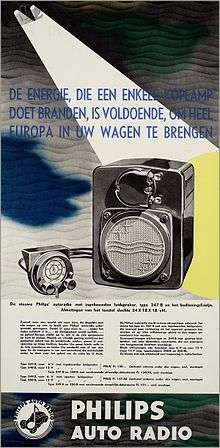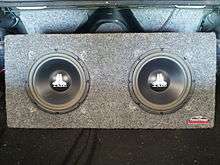Vehicle audio
Vehicle audio is equipment installed in a car or other vehicle to provide in-car entertainment and information for the vehicle occupants. Until the 1950s it consisted of a simple AM radio. Additions since then have included FM radio (1952), CD players (1985), navigation systems, Bluetooth telephone integration, and smartphone controllers like CarPlay and Android Auto. Once controlled from the dashboard with a few buttons, they can now be controlled by steering wheel controls and voice commands.
Initially implemented for listening to music and radio, vehicle audio is now part of car telematics, telecommunication, in-vehicle security, handsfree calling, navigation, and remote diagnostics systems. It is also used to create fake engine noise.[1] For the 2015 Ford Mustang EcoBoost, an "Active Noise Control" system was developed that amplifies the engine sound through the car speakers. A similar system is used in the F-150 pickup truck. Volkswagen uses a Soundaktor, a special speaker to play sounds in cars such as the Golf GTi and Beetle Turbo. BMW plays a recorded sample of its motors through the car speakers, using a different samples according to the engine’s load and power.[2]
History

Around 1920, vacuum tube technology had matured to the point where the availability of radio receivers created the audience that made radio broadcasting viable.[3] A technical challenge was that the vacuum tubes in the radio receivers required 50 to 250 volt direct current but car batteries ran at 6V. Voltage was stepped up with a vibrator that provided a pulsating DC which could be converted to a higher voltage with a transformer, rectified, and filtered to create higher-voltage DC.
In 1930, the American Galvin Manufacturing Corporation marketed a Motorola branded radio receiver for $130.[4] It was expensive: the contemporary Ford Model A cost $540. A Plymouth sedan, "wired for Philco Transistone radio without extra cost," is advertised in Ladies' Home Journal in 1931. In 1932 in Germany the Blaupunkt AS 5 medium wave and longwave radio was marketed for 465 Reichsmark, about one third of the price of a small car. Because it took nearly 10 litres of space, it could not be located near the driver, and was operated via a steering wheel remote control.[5] In 1933 Crossley Motors offer a factory fitted car radio.[6] By the late 1930's, push button AM radios were considered a standard feature. In 1946 there were an estimated 9 million AM car radios in use. [7]
An FM receiver was offered by Blaupunkt in 1952. In 1953, Becker introduced the AM/FM Becker Mexico with and a station-search or scan function.[8]
In April 1955, the Chrysler Corporation had announced that it was offering a Mopar model 914HR branded Philco all transistor car radio,[9] as a $150 option for its 1956 Chrysler and Imperial car models. Chrysler Corporation had decided to discontinue its all transistor car radio option at the end of 1956, due to it being too expensive, and replaced it with a cheaper hybrid (transistors and low voltage vacuum tubes) car radio for its new 1957 car models.[10] In 1963 Becker introduced the Monte Carlo, a tubeless solid state radio, with no vacuum tubes.[8]
In 1964 Philips launched the Compact Cassette, and in 1965 Ford and Motorola jointly introduced the 8-track tape in-car tape player. In subsequent years cassettes supplanted the 8-track, and improved with longer play times, better tape quality, auto-reverse, and Dolby noise reduction. They were popular throughout the 1970s and '80s. Stock and aftermarket compact disc players began appearing in the late 1980s, competing with the cassette. The first car with an OEM CD player was the 1987 Lincoln Town Car, and the last new cars in the American market to be factory-equipped with a cassette deck in the dashboard was the 2010 Lexus,[11] and the Ford Crown Victoria.[12]
From 1974 to 2005 the Autofahrer-Rundfunk-Informationssystem was used by the German ARD network.[13] Developed jointly by the Institut für Rundfunktechnik and Blaupunkt,[14] it indicated the presence of traffic announcements through manipulation of the 57kHz subcarrier of the station's FM signal.[15] ARI was replaced by the Radio Data System.[16]
In the 2010s new ways to play music came into competition with the CD and FM radio such as internet radio, satellite radio, electrical connectors and Bluetooth connectors for portable media players, and in-dash slots for memory cards. And the automobile head unit became increasingly important as a housing for backup cameras, navigation systems, and displays for smartphones such as CarPlay, Android Auto, and MirrorLink. Some vehicle manufacturers have their own systems for syncing the car with smartphones, for example: BMW Assist, Hyundai Blue Link, iLane, MyFord Touch, Ford SYNC, OnStar, and Toyota Entune.
Components and terms
- Stock system: the OEM application that the vehicle's manufacturer specified to be installed when the car was built.
- Head unit: Car stereos generally lag behind audio technology.[17] Cassette decks have been found in cars as late as the 2008 Acura TL, and even in the 2010s the CD player is still a standard part of most car stereos, although their non-car counterparts (i.e. Walkmans) have long disappeared from consumer shelves. For decades most vehicle dashboards had a rectangular "cutout" where the head unit was installed (which went above another rectangular cutout for the HVAC controls), and this allowed for straightforward replacement of the stock system with an aftermarket stereo, since audio technology improves faster than model updates from car companies. These cutouts, however, also allowed for easy theft of the car radio.[18] Due to auto manufacturing differences over the years, aftermarket headunit products are manufactured in multiple form factors. The primarily used size is mostly referred to by its legacy name of DIN, which refers to ISO 7736. DIN headunits come as single DIN or double DIN. The trend away from dashboards with cutouts, along with improving car audio technology, has eroded sales from the aftermarket stereo industry.[18]
- Car speakers
- Mobile audio power amplifiers
- Subwoofers
- Capacitors
- Damping: sound deadening material is often used in the door cavities and boot/trunk area to damp excess vibration of the panels in the car in response to loud subwoofer bass tones, especially the boot/trunk.
Legality
Extremely loud sound systems in automobiles may violate the noise ordinance of some municipalities some of which have outlawed them.[19] In 2002, the U.S. Department of Justice issued a guide to police officers on how to deal with problems associated with boom cars.[20] A number of companies have engaged in the irresponsible advertising of high powered automotive audio systems; often, such advertisements encouraged anti-social behaviour such as annoying neighbours when played at a high volume level, including through taglines such as "Turn It Down? I Don’t Think So".[21]
Gallery
- 1955: World's first All-Transistor car radio - Chrysler Mopar 914HR / Philco model C-5690
 A 1950s Philips car radio using both transistor and valves
A 1950s Philips car radio using both transistor and valves- GM Delco Transistorized "Hybrid" (vacuum tubes and transistors), first offered as an option on the 1956 Chevrolet Corvette car models.
 A car stereo head unit in a dashboard
A car stereo head unit in a dashboard- 1942 Lincoln Continental Cabriolet radio
 1964 Mercedes-Benz W110 190c dashboard with original FM Blaupunkt "Frankfurt" head unit.
1964 Mercedes-Benz W110 190c dashboard with original FM Blaupunkt "Frankfurt" head unit._deLuxe_Two_door_1958_Radio_Blaupunkt_K%C3%B6ln.jpg) BLAUPUNKT Köln Radio - German 1958 FORD Taunus 17M P2 deLuxe
BLAUPUNKT Köln Radio - German 1958 FORD Taunus 17M P2 deLuxe 1968 AMC Rebel 770 with optional AMC AM/FM radio
1968 AMC Rebel 770 with optional AMC AM/FM radio 1990 Ford Sierra CLX Radio-Cassette head unit in a dashboard with cassette storage
1990 Ford Sierra CLX Radio-Cassette head unit in a dashboard with cassette storage 1978 AMC Matador sedan factory AM-FM-stereo-8-track unit with album by The Blues Brothers
1978 AMC Matador sedan factory AM-FM-stereo-8-track unit with album by The Blues Brothers A factory headrest on a Pontiac Fiero embedded with stereo speakers. Eliminated on later models due to cost.
A factory headrest on a Pontiac Fiero embedded with stereo speakers. Eliminated on later models due to cost. A set of speaker drivers removed from a passenger vehicle
A set of speaker drivers removed from a passenger vehicle- A car audio amplifier

 Two 10-inch sub-woofers in the trunk of a car
Two 10-inch sub-woofers in the trunk of a car After-market speaker system in the cargo area
After-market speaker system in the cargo area- After-market speakers in the cargo area
 Radio scanner installed with aftermarket head unit
Radio scanner installed with aftermarket head unit_Head_Unit.jpg) As technology keeps evolving, head units are now paired with air-conditioners and other essentials. They are now equipped with anti-theft system for anti-stealing purposes.
As technology keeps evolving, head units are now paired with air-conditioners and other essentials. They are now equipped with anti-theft system for anti-stealing purposes.
See also
References
- ↑ Harwell, Drew (2015-01-21). "America's best-selling cars and trucks are built on lies: The rise of fake engine noise". The Washington Post. ISSN 0190-8286. Retrieved 2016-01-16.
- ↑ "The Rise of the Fake Engine Roar". Popular Mechanics. 2012-08-02. Retrieved 2016-01-16.
- ↑ Guarnieri, M. (2012). "The age of vacuum tubes: the conquest of analog communications". IEEE Ind. Electron. M.: 52–54. doi:10.1109/MIE.2012.2193274.
- ↑ "The History of Car Radios". Car and Driver. Retrieved 14 January 2016.
- ↑ "BLAUPUNKT: Success Story". www.blaupunkt.com. Retrieved 2016-01-14.
- ↑ Harding (ed) (1977). Guinness book of car facts and feats. London: Guinness Superlatives. ISBN 0-900424-54-0.
- ↑ "When the Car Radio Was Introduced, People Freaked Out". MentalFloss. Retrieved 2016-08-10.
- 1 2 "The History of the Car Stereo". PCMAG. Retrieved 2016-01-14.
- ↑ "Mopar 914-HR Ch= C-5690HR Car Radio Philco, Philadelphia". www.radiomuseum.org. Retrieved 2016-01-14.
- ↑ Hirsh, Rick. "Philco's All-Transistor Mopar Car Radio". Allpar.com. Retrieved February 18, 2015.
- ↑ Williams, Stephen (2011-02-04). "For Car Cassette Decks, Play Time Is Over". The New York Times. ISSN 0362-4331. Retrieved 2016-01-14.
- ↑ "The in car cassette deck lives on for one more year".
- ↑ "Institut für Rundfunktechnik Historic Milestones". Archived from the original on 20 April 2009. Retrieved 2009-05-17.
- ↑ "March 2009: RDS is now 25 – the complete history" (PDF). Geneva, Switzerland: The RDS Forum. 2009-03-27. p. 1. Archived from the original (PDF) on October 7, 2009. Retrieved 2009-05-17.
- ↑ EP 1432157
- ↑ "Das Autofahrer-Rundfunk-Informationssystem wird abgeschaltet" (in German). Regensburg, Germany: ShortNews GmbH & Co. KG. 2005-02-28. Retrieved 2009-05-17.
- ↑
- 1 2 Mays, Kelsey (November 7, 2011). "No More Cutouts: Where Do Aftermarket Stereos Go?". Blogs.cars.com. Retrieved February 18, 2015.
- ↑ "Boom Cars, Noise Free America". Noisefree.org. Retrieved February 18, 2015.
- ↑ Scott, Michael S. (May 22, 2002). Loud Car Stereos (PDF). U.S. Department of Justice, Community Oriented Policing Services. Retrieved February 18, 2015.
- ↑ http://www.noiseoff.org/ads.php
